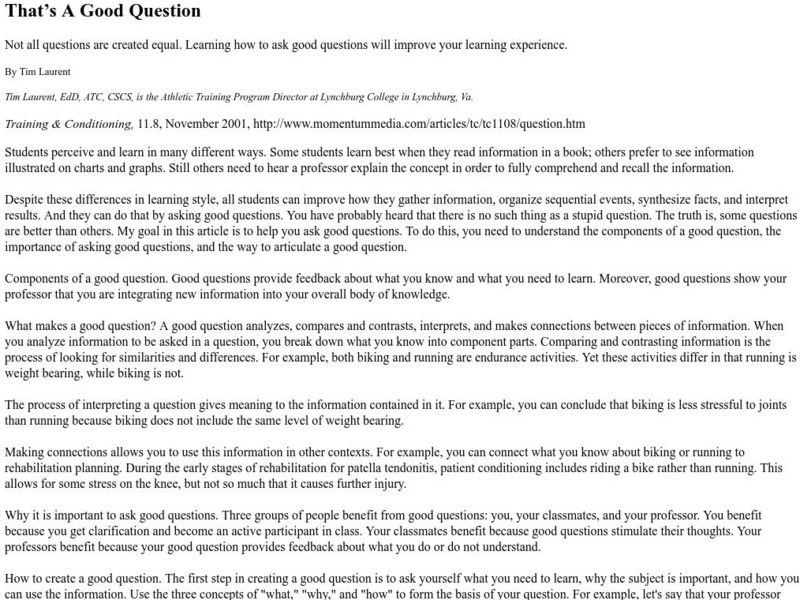AdLit
Ad lit.org: Extended Writing to Learn Strategies
Writing enables students to process, organize, formulate, and extend their thinking about what they have been learning. In addition, teachers can also assign writing to help students evaluate what they know and understand about a topic....
Other
Reading Educator: Question Answer Relationships
Based on the presumption that every teacher shares responsibility for teaching reading, this page offers a brief look at question-answer relationships, as well as suggestions for putting the strategy to use in the classroom.
Other
Fpc of St. Louis: Interview Strategies
A complete overview of proper preparation for a job interview. It discusses appropriate dress, preparing your questions and how to close the interview.
Other
Questioning.org: The Question Mark
Jamie McKenzie's book, Beyond Technology: Questioning, Research and the Information Literate School, emphasizes the need to teach children to ask important questions, then research the answers, instead of just learning information...
Other
That's a Good Question
While the specific questions proposed here relate to physical therapy, the method of designing good questions that is taught can be used universally. The author teaches a pattern of asking "What" "Why" and "How" to develop successively...
Other
Self growth.com: The Art of Communicating
On this site, Hal Warfield explains interpersonal communication and examines the communication process. Words highlighted in blue offer links to more information on the topic.
Other
Tonya Skinner: Job Interview Scoring Rubric
This site presents a scoring rubric for job interviews. Topics included are First Impressions, presentation, personal attributes, general attitude, personal appearance and responses.
ReadWriteThink
Read Write Think: K W L S Chart
A printable K-W-L-S sheet to help students activate prior knowledge, ask questions, record new learning, and then ask additional questions to extend inquiry beyond the text . Directions on how to use this type of graphic organize as well...
ReadWriteThink
Read Write Think: Get the Gist: A Summarizing Strategy for Any Content Area
A five-part standards-based lesson plan in which students learn to write a 20 word summary of an informational text by focusing on answering the questions who, what, when, where, why, and how. This strategy can be applied to any content...
ReadWriteThink
Read Write Think: Questioning a Comprehension Strategy for Small Group Reading
Contains plans for three lessons about asking the right questions while reading. After the teacher explains the difference between factual and inferential questions, students practice using them in small-group guided reading. In addition...
ReadWriteThink
Read Write Think: Guided Comprehension: Making Connections
Lesson introduces young scholars to the strategy of making connections. Students learn the three types of connections using a double-entry journal. A good resource for teachers.
University of Michigan
University of Michigan: Being a Good Listener Is Hard Work
"As a speaker, there are several things you can look for to determine if your message is being received. On the flip side, these are good characteristics to have when you are the listener." This article gives some startling statistics...
ReadWriteThink
Read Write Think: Guided Comprehension: Self Questioning
Online lesson introduces students to the concept of self-questioning, assisting them in an understanding of question-answer relationships that should improve their reading comprehension skills. In-depth study will lead to improved...
ReadWriteThink
Read Write Think: Guided Comprehension: Summarizing
Lesson that introduces students to the comprehension technique of summarizing. Students learn using the QuIP (questions into paragraphs) method which involves organizing information and putting it in writing.
Other
Literature Circles Resource Center: Teaching Students How to Discuss
Teachers are given strategies and hands-on approaches to help students prepare for a discussion and participate as active members of it.
Sophia Learning
Sophia: Asking Clarifying Questions: Lesson 2
At the end of this tutorial, the learner will be able to ask appropriate and effective questions to better understand a communication or situation. It is 2 of 3 in the series titled "Asking Clarifying Questions."
Other
Youth Learn: The Key to Engaging Students in Learning: Asking Good Questions
Explanation of several types of questions, and suggestions for helping students use good questioning techniques in inquiry-based learning. SL.9-10.1c Active Partic
Free Management Library
Map: General Guidelines for Conducting Interviews
Interesting site. Delineates the sequence, topics, and wording for interview questions. Explains the different types of interviews and has useful links to other resources. Although designed for an interviewer, this site should also be...
College Grad
Job Hunter: The Nonverbal Interview Technique
This article discusses the non-verbal communications skills that need to be mastered in order to succeed in an interview.
University of Victoria (Canada)
Study Zone: Yes/no Questions in the Simple Present Tense
This site explains how to change sentences into simple Yes/No questions. You can actually practice doing this interactively on this site.
Sophia Learning
Sophia: Planning Your Answer
In this slide show tutorial, students will review how to approach answering short answer and extended response essay questions. Marking strategies examples are included.
Sophia Learning
Sophia: Planning Your Answer
In this slide show tutorial, students will review how to approach answering short answer and extended response essay questions. Marking strategies examples are included.
Sophia Learning
Sophia: Reading Strategies: Tutorial
In this slideshow tutorial, students will review different types of reading strategies to promote comprehension of text. The strategies included are the following: making predictions, visualizing, questioning the text, retelling,...
BBC
Bbc: Skillswise: Listening for Specifics
This Skillswise site focuses on listening for specifics. Included are a video about why learning how to do this, fact sheets and worksheets for instruction, quizzes on the information presented, and games to practice the skill. The...
























